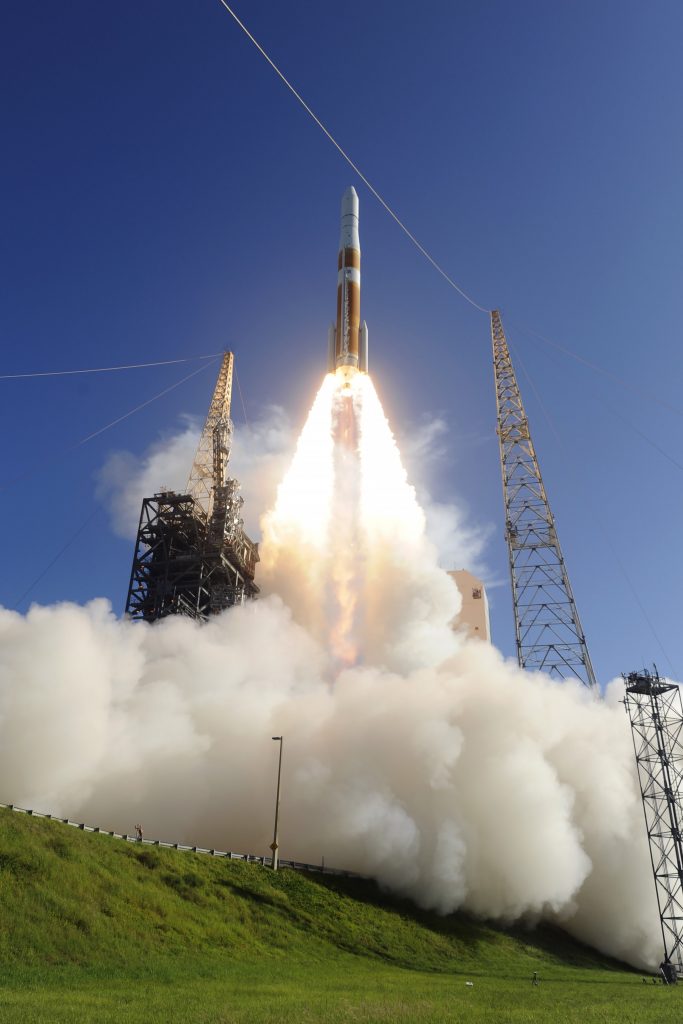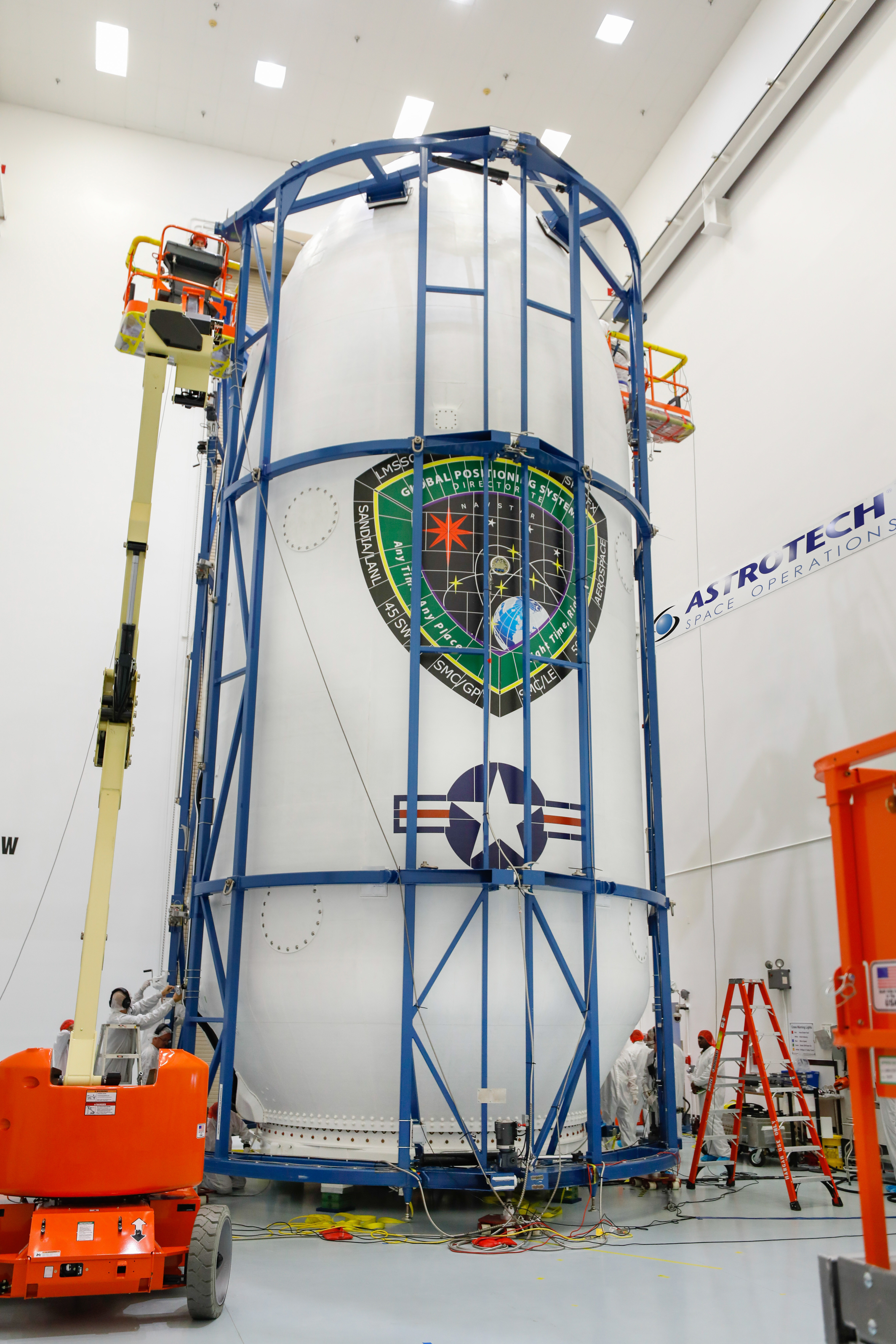The second Lockheed Martin-built GPS III space vehicle (GPS III SV02)—also known as Magellan—was recently encapsulated within its protective fairings in preparation for Thursday’s scheduled launch. GPS III will launch tomorrow from Space Launch Complex-37 (SLC-37) at Cape Canaveral Air Force Station, Florida.
The Global Positioning System (GPS) III government, contractor and mission team hosted a media teleconference on August 19 and announced everything was on track for launching the second GPS III satellite on Thursday, Aug. 22, with its 27-minute launch window opening at 9:00 a.m. EST. The team, led by SMC’s Production Corps and Launch Enterprise, also announced the GPS III program to be “in good shape and able to meet the demands of maintaining a healthy constellation for worldwide use.”
GPS III SV02, named Magellan in honor of the Portuguese explorer who led the first expedition to circumnavigate the Earth, was originally scheduled to be launched last month but was pushed back. The United Launch Alliance (ULA) stated in a published report the delay was due to “an anomaly during component testing at a supplier that created a cross-over concern.” Upon further evaluation, ULA determined additional time was needed to replace and retest the component on the launch vehicle.
With everything now in order, a launch webcast is expected to start at 8:40 a.m. EDT (1240 UTC). For information on how to watch the launch live, visit the United Launch Alliance website at https://www.ulalaunch.com/missions/delta-iv-gps-iii-sv-2
The GPS III SV02 team is led by the Space and Missile Systems Center’s Production Corps, located at Los Angeles Air Force Base, California. The launch team is led by SMC’s Launch Enterprise and is using the ULA Delta IV launch vehicle at Cape Canaveral Air Force Station, Florida. Lockheed Martin Space Systems Corporation is the prime space vehicle contractor. Air Force Space Command’s 50th Space Wing and 2nd Space Operations Squadron operate the GPS constellation from Schriever AFB, Colorado.
The GPS III SV02 satellite will be launched on a ULA Delta IV (4,2) rocket. This is the 15th and last launch of this specific configuration (4,2), and the final launch of the Delta IV Medium launch vehicle family. There are five remaining launches of the Delta IV Heavy configuration. GPS III SV02 will replace SVN-45 after it is set healthy sometime next year, it was stated on Tuesday.

Background
In May 2008, the first GPS III increment contract was awarded to Lockheed Martin for the development and production of two initial space vehicles (SVs), with options for up to 10 additional SVs. GPS is a National Security Space (NSS) mission, critical to national defense. In April 2016, SpaceX was awarded its first NSS launch mission, GPS III-2. SpaceX currently has an additional four GPS III SVs on contract, all of which will be launched on a Falcon 9. SpaceX launched SV01 in December 2018, SV02 was scheduled to launch on United Launch Alliance’s Delta IV in July, SV03 is scheduled to launch in late 2019, SV04 is scheduled to launch in 2020, and SVs 05-06 are options expected to launch in the near future.
GPS III SVs are designed to introduce new capabilities to meet higher demands of both military and civilian users. It brings the full capability to use M-Code in support of Warfighter operations. GPS III nominal M-Code capability exceeds maximum GPS IIF and GPS IIR M-Code capability (Flex power without P(Y)-Code). It expands international cooperation in the Global Navigation Satellite System (GNSS) arena by fielding the L1C signal interoperable with Galileo, Quazi-Zenith Satellite System (QZSS) and other GNSS systems. GPS III is needed to complete the deployment of L2C and L5 signal capabilities that began with the modernized GPS IIR-M and GPS IIF satellites. Using an incremental approach, new capabilities that require technical maturity or have greater risks of being properly integrated are deferred to the later increments, ensuring low-risk and high-confidence delivery of capabilities.
Capabilities Include:
- Improved anti-jam
- Improved accuracy
- Improved integrity
- First satellite to broadcast common L1C signal compatible with Galileo
- Multiple civil/military signals: L1 C/A, L1 P(Y), L1M, L1C, L2C, L2 P(Y), L2M, L5
- +10dB Earth coverage power increase on M-Code without diminishing power to other military signals
- Three rubidium clocks
Additional details provided by the team include:
- There are currently two residual satellites: SVNs 36, 38 as well as one test satellite, SVN-49.
- SVN 34 is the oldest active satellite. It is a GPS IIA launched 26, October 1993.
- The IIR spacecraft that is being replaced by SV02 will move into residual status.
- Since SV02 is the second GPS III satellite, the team expects to monitor it for about one month on orbit to ensure that it is completely reliable once it is set healthy, and that updates to the ground control system are complete. After that, progress of the ground station upgrades will determine when it will enter operations.
- To ensure the most efficient GPS III production process, GPS III was assembled at Lockheed Martin’s multi-capability GPS Processing Facility (GPF) in Waterton, Colorado. This is the assembly, integration and test (AI&T) location for the entire GPS III fleet.
- Delta IV was manufactured at United Launch Alliance’s factory in Decatur, Alabama
- In terms ofcost, the figure has actually gone down over time as “we improve and learn. The first GPS III satellite is more than half a billion dollars, while the last two were less than $200 million.
- The satellite will be placed into orbital slot D3 to optimize coverage for GPS users.
- New capabilities will allowit to broadcast a total of four civil signals for increased interoperability, reception, and “safety-of-life.”
- GPS satellites travel at approximately 8,700 mph (14,000 km/h) with respect to Earth. GPS satellites fly in Medium Earth Orbit (MEO) at an altitude of approximately 20,200 km (12,550 miles). Each satellite circles the Earth twice per day.






